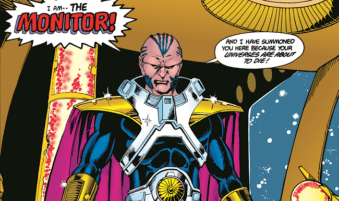In the week leading up to The CW’s annual DC superhero shows crossover event, Crisis On Infinite Earths, we take a multi-part look at the five-night event’s origins in one of DC Comics biggest stories ever, some of the unexpected superheroes who will be appearing and what we may expect from the event.
In this first part, we look at the original 1985 12-part comic book mini-series that is supplying the inspiration for the coming event.
As last year’s annual CW network DC superhero show crossover event, Elseworlds wrapped up its story, it dropped a bombshell on viewers in its closing moments – that 2019’s crossover will be titled Crisis On Infinite Earths. An intriguing title for viewers who weren’t necessarily well versed in comic book lore, but an exciting revelation for fans who are familiar with the groundbreaking and iconic 1985 comic book event series that redefined the DC universe.
Crisis On Infinite Earths is the brainchild of DC Comics writer Marv Wolfman. The DC Comics writer had concerns that the multiple Earths the comics company used to place various stories, older versions of some characters like Superman and Batman and characters acquired from other companies was just too daunting and confusing for potential new readers. And with Marvel Comics, and their just-one-world approach to their comics interconnected continuity, having a much larger market share than DC Comics did, there may have been something to his concerns. In order to streamline DC’s continuity, Wolfman proposed a giant 12-part saga that would spotlight nearly every heroic character from the publishers fifty year history in a story that would rearrange the continuity of the DC Comics universe right down to its bones.
 In Crisis On Infinite Earths, a mysterious being called the Monitor brings together a collection of superheroes to stop his evil doppelganger, the Anti-Monitor. The Anti-Monitor originated in the Anti-Matter Universe and wants to destroy every positive matter universe there is, and has already made good headway towards that goal as the story starts.
In Crisis On Infinite Earths, a mysterious being called the Monitor brings together a collection of superheroes to stop his evil doppelganger, the Anti-Monitor. The Anti-Monitor originated in the Anti-Matter Universe and wants to destroy every positive matter universe there is, and has already made good headway towards that goal as the story starts.
The collection of heroes that the Monitor has assembled originated from across space and time, ranging from prehistory’s Anthro to the 30h Century’s Legion of Super Heroes and consisted of every single super hero character that DC Comics had published in their 50 year history. And across the comic series 12-issue run saw them journeying from the moment of the universe’s creation to the far future, across multiple Earths and from the planet Oa at the center of the universe, home of the Guardians of the Universe and the Green Lantern Corps, to the Qward in the heart of the Anti-Matter universe.
The heroes valiantly try to fight for their worlds, but soon the Anti-Monitor has whittled down the multiverse to just five remaining Earths. To make matters worse, a number of supervillains team together to try and take over the worlds for themselves. By the end of the story, many heroes – including Supergirl and the Flash – have made the ultimate sacrifice and the remaining worlds have all been merged into one Earth with one (mostly) cohesive history.
It was a risky gamble for the publishers. The potential to turn off hardcore fans who liked the company’s vast, complex continuity and cosmology was very high. But Wolfman’s story and Perez’s artwork told a story that was both epic and sprawling yet still delivered the emotional moments as heroes and their loved ones fought on against what appeared to be an insurmountable foe. Many charged ahead towards their death, willingly so if they knew it would give another person even just a little bit more life. In that way, Crisis On Infinite Earths not only redefined the DC Comics Universe, it but it kept defining what it meant to be a hero and how its characters would live up to that ideal.


